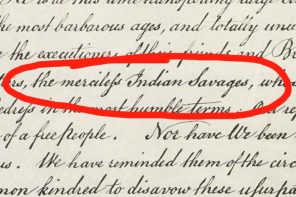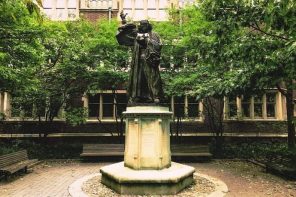Darwin’s Sacred Cause:
How a Hatred of Slavery Shaped Darwin’s Views on Human Evolution
Adrian Desmond and James Moore
(Houghton Mifflin Harcourt, 2009)
Much of my professional life sails upon the ship that Darwin built. I am a molecular geneticist; I earned a PhD in studying phenomena in yeast—phenomena we know occur in all organisms; I teach biology; I write on the ways in which science and religion interact or don’t. And so much of that conversation, in America, is interwoven with Darwin’s theory of evolution.
But until reading Adrian Desmond and James Moore’s Darwin’s Sacred Cause, I had never fully realized how significant Darwin’s impact on my life has been.
I grew up in the American South, and still live there; my life and ideas have been immersed in race. I was a subject of odd racial integration experiments like turning all the former ‘black’ schools in town into ‘sixth-grade centers’ and then bussing all of us sixth graders in town to those centers. Marjorie Scott, my seventh grade Social Studies teacher, added a whole unit on the American Civil Rights Movement to our class—because this bit of history was not mentioned in our text. My mother was part of a group of women—a Jew, a Catholic, and an African American—that toured high schools to talk on race and religion and allow the students to meet people who were not like themselves, in many cases for the first time. These are the type of experiences that shaped me, that shape all Southerners.
In Sacred Cause Desmond and Moore argue, with overwhelming evidence, that Darwin, too, was immersed in issues of race from the day he was born, and that his abhorrence for racism shaped him and the theories and ideas for which he’s famous. Darwin, as we see in Sacred Cause, following in his grandfather’s and in-laws’ footsteps, was a passionate abolitionist.
Building on their 1991 biography and on undiscovered letters, Desmond and Moore weave an engaging narrative. If anything, Sacred Cause suffers, ironically, from its own kind of Darwin-ism. As the authors point out, Darwin was so meticulous, with such careful and exhaustive attention to detail that, for example, his study of barnacle diversity included every type of barnacle on Earth and took eight years to complete! Sacred Cause, and the story of Darwin and race could have been made tighter and sleeker by moving much more of the text to the extensive notes section in the back of the book.
But, one can hardly complain of too much of a good thing. The grand sweep of the book held me in its grip by accomplishing the two great literary goals of any history: telling a good story in a new light and demonstrating how that story raises big questions that resonate in the present, back through time, and into the future.
A Common Ancestor
Many of us nerds knew Darwin was a medical school dropout, but how many of us knew that Edinburgh University where Darwin went was the center of the then-new science of phrenology and craniology (reading personality from the bumps on the skull, or from its size and shape)? And that these ideas and those who developed them greatly influenced Darwin and the soon-to-be-born science of human race called anthropology?
Darwin’s famous voyages on the Beagle through Brazil and the Galapagos, during which he formed and shaped the ideas of natural selection and adaptation that made him famous, have become part of Western myth. But how many of us knew that at many stops on the voyage, Darwin witnessed slavery at its worst? As we learn, Darwin once met and supped with a white general bent on eliminating an entire native South American tribe, and on another occasion witnessed the torture of a woman slave in thumbscrews. Such incidents confirmed Darwin in his strong belief in the evil of slavery and strengthened his desire to demonstrate—scientifically—that we all share a common ancestor, and are equal, through and through.
Again, many know of Darwin’s Galapagos finches, and how he demonstrates natural selection by using beak size and shape in relation to the food they ate, on which islands the food was, and where the finches lived. But I hadn’t the slightest idea that underlying Darwin’s work on the finches was a very human concern about race. In fact, his work on all of the following organisms was driven by racial concerns: slave ants (red-colored ants that live in Britain and keep ‘slave’ ants, which happen to be black, as protectors of their nests and were cited as support for the ‘naturalness’ of slavery by slave owners); domestic pigeons (that had been maintained and trait-selected for ages on the rooftops of the British lower class with whom other scientists didn’t deign to talk); and even seeds soaked in salt water for days. (Darwin’s house was, for a time, a virtual botanical garden of seeds from all over the world, soaked and then grown in soil to demonstrate that plant seeds could easily move in the oceans over very long distances to take root again. Scientists of the time maintained that species couldn’t move from place to place via seawater, but none had ever bothered to do the experiment and test the idea.)
Darwin did all this work to demonstrate that all species of a particular type—barnacle, pigeon, plant—originated from a common ancestor. You see, a predominant view at the time, expounded in countless ‘scientific tomes’—including those of radical pro-slavery Harvard biologists in league with racist Alabaman physicians and many British scientists—claimed something different, called plurality, namely that every species evolved separately and independently from a distinct original source in each separate location, even after a great cataclysm (ice age, fire, etc.).
And here’s the kicker, here’s why this amounted to so much more than esoteric egghead argument: the advocates of plurality held that their arguments were true for humans as well (actually for humans especially) and claimed black people and other human types (divided most often by skin color and degree of ‘civilized behavior’) were each separate, independent species. So, it was okay to treat blacks like slaves. In fact higher species like whites were obligated to treat them as separate and lower, because they were.
No, says Darwin emphatically, we are all of the same origin and are all the same related species, from one common ancestor. After two decades of hesitation he finally published his theories in The Origin of Species (although even in Origin he mentions human natural selection and common descent only by implication). The book was published a week before John Brown was hanged for inciting the famous failed slave revolt in Harper’s Ferry, Virginia.
The Sacred Cause storyline that links Darwin’s theories of evolution and racism is a powerful and convincing one.
What About Us?
Another reason to read the book is that its story raises and addresses profound questions for me, for all of us, as we sail through life on the ship that Darwin built. How closely should science and scientists be linked to society and politics? During Darwin’s time, many scientists were also members of the clergy or brought their science, such as it was, directly and explicitly into the political discussions of the day. Are the scary racist results covered in Sacred Cause one reason scientists today so isolate themselves from public conversation? What are the costs and benefits of this isolation?
And one question that kept nagging at me as I read of the strong, vocal, ‘data-filled’ support of prominent scientists for racism and slavery: what awful things am I, are we, doing now that future generations will look back on in horror? What ideas are we clinging to so tightly that if we’d only let them go, we’d be freer and more complete as the species Homo sapiens?




